- Home
- About us
- Activities
-
About us
- News & Update
- Library
- Countries
- extra
- contact
extra
Click Show/hide
- Extras 2017
- Extras 2016
- Extras in October
- Earthquake - Updates from Friends in Nepal
- ACHR Extras April - September
- Extras for 2015
- December Photos PLUS
- November Photos Plus
- Photos October 2014
- Photos for August September
- Photos for July 2014
- Photos for May 2014
- Photos for March 2014
- Fr Norberto 1951 - 2014
- In-House Inspiration
- About the new website ...
Earthquake - Updates from Friends in Nepal
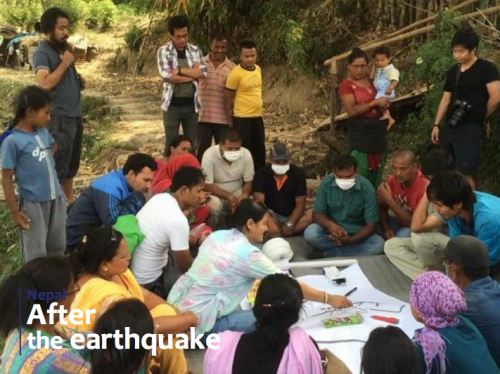
Following the catastrophic earthquake, Mahavir, Nad and Net - representing the Community Architect Network and Hunnarshala Foundation - went to Nepal to identify possible areas of intervention with the local organization Lumanti. The following download is a 2 page extract from the NEW CAN newsletter (July 2015) of their most productivecollaboration with survivors .

PDF 2 pages from CAN Newsletter : After the Quake 2.6 mbs Posted 2 Sept 2015

PDF 2 pages from CAN Newsletter : After the Quake 2.6 mbs Posted 2 Sept 2015
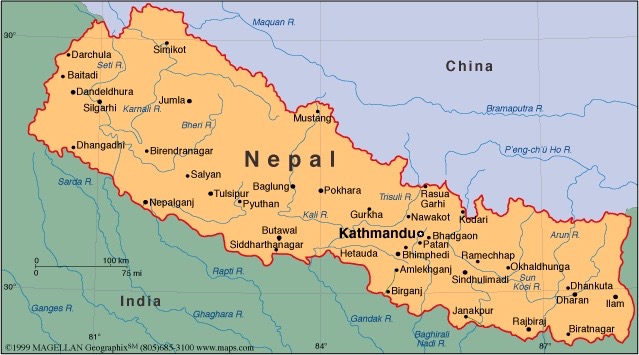
From June 2015: (Almost) Daily updates can be seen at FACEBOOK page of our friends at Lumanti Support Group for Shelter
https://www.facebook.com/lumanti.shelter
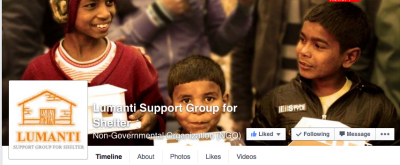 Updates of learnings, experiences, impacts of people centred recovery and many descriptive photos.
Updates of learnings, experiences, impacts of people centred recovery and many descriptive photos.
JUNE 2015 Community Architects Suppport Lumanti in Nepal Watch the video from our video page HERE 8 mins 30 s
Our CAN team, Mahavir ( from Hunnarshala has extensive experience in rehabilitation after the Gujarat earthquake in India), Nad with rehabilitating tsunami affected villages in southern Thailand) and Net met with Lumanti to explore ways for long term recovery after the earthquake. We got support funding for assessment trip and emergency relief from MISEREOR.
The Lumanti team had already been working with 10 old towns around the Kathmandu valley to set up relief programs with communities in all of the 10 old towns which had already started women saving cooperative 5-10 years before earthquake, and the women’s cooperatives as played an important role in managing funds and donations to support the affected members. Lumanti helps to facilitate and channel funds and relief materials and also support temporary shelter through the women cooperative to make sure that community are managed well and ensure benefits to all the member in need and prioritise poorest.
From the survey of Lumanti and community the demand for temporary shelter in 10 old town are around 800 units and Lumanti and PTAG helped community to set up temporary shelter that people could build by themselves, fit with their life style and maximise use of the old materials. Lumanti was able to help channel funds to build 300 temporary shelters.
From the information from government the earthquake effected 14 districts and more than 500,000 houses had collapsed.
We visited 4 areas, 3 old towns[ Mechchagaon,Thecho, Siddhipur] and 1 rural area in Dhading in Jeevanpur village.
After field visited we discussed and shared ideas from what we had observed of the damage in old towns and then we proceeded with 3 initiatives.helter in their rehabilitation efforts after the earthquake. Below is a slightly edited version of Chawanad ansang
https://www.facebook.com/lumanti.shelter
 Updates of learnings, experiences, impacts of people centred recovery and many descriptive photos.
Updates of learnings, experiences, impacts of people centred recovery and many descriptive photos.JUNE 2015 Community Architects Suppport Lumanti in Nepal Watch the video from our video page HERE 8 mins 30 s
Extrcted from ACHR E-Nes June 2015
ACHR, CAN Support Lumanti in Nepal
ACHR through the Community Architects Network made a visit to Nepal to help support local group Lumanti Support Group for Shelter in their rehabilitation efforts after the earthquake. Below is a slightly edited version of Chawanad Luansang - Nad’s report on the visit. 31.05 - 10.06.2015 AC
Our CAN team, Mahavir ( from Hunnarshala has extensive experience in rehabilitation after the Gujarat earthquake in India), Nad with rehabilitating tsunami affected villages in southern Thailand) and Net met with Lumanti to explore ways for long term recovery after the earthquake. We got support funding for assessment trip and emergency relief from MISEREOR.
The Lumanti team had already been working with 10 old towns around the Kathmandu valley to set up relief programs with communities in all of the 10 old towns which had already started women saving cooperative 5-10 years before earthquake, and the women’s cooperatives as played an important role in managing funds and donations to support the affected members. Lumanti helps to facilitate and channel funds and relief materials and also support temporary shelter through the women cooperative to make sure that community are managed well and ensure benefits to all the member in need and prioritise poorest.
From the survey of Lumanti and community the demand for temporary shelter in 10 old town are around 800 units and Lumanti and PTAG helped community to set up temporary shelter that people could build by themselves, fit with their life style and maximise use of the old materials. Lumanti was able to help channel funds to build 300 temporary shelters.
From the information from government the earthquake effected 14 districts and more than 500,000 houses had collapsed.
We visited 4 areas, 3 old towns[ Mechchagaon,Thecho, Siddhipur] and 1 rural area in Dhading in Jeevanpur village.
After field visited we discussed and shared ideas from what we had observed of the damage in old towns and then we proceeded with 3 initiatives.helter in their rehabilitation efforts after the earthquake. Below is a slightly edited version of Chawanad ansang
1. for planning the old town in Tauchel,Mechchagaon where 70% of their houses had collapsed. We spent 3 days working with the community to survey existing maps and make plans to reorganise the community to enable better infrastructure and maintain the community’s cultural heritage.
2. we visited old houses and analyse the structures and tried to find solutions for what should be the low-cost housing that could use local materials, local artisans and enrich the heritage of the settlement. We found that old Newar houses could be rebuilt and retrofitted and some changes could be made to improve ventilation and bring more natural light into the houses. We continue to are carry on with the design and study more.
3 We have found many old houses in the old town are able to retrofit but most of the owner of old house lost confident in their old house and want to knock down their house and want to rebuild new concrete house. We and Lumanti organise meeting and workshop focus on encourage people to do retrofit their old house which are strong enough and they can save a lot of money and can preserve and maintain living heritage.
For now the Lumanti team plan to build more temporary shelters and together, with the people, carry out mapping and surveys in 8 old towns to bring people together to plan for recovery and explore the ideas on finance models and mechanisms for community recovery. Our CAN team with Hunnarshala will carry on to support the recovery process in Nepal.
Report above from Nad Chawanad Luansang in collaboration with Lumanti
2. we visited old houses and analyse the structures and tried to find solutions for what should be the low-cost housing that could use local materials, local artisans and enrich the heritage of the settlement. We found that old Newar houses could be rebuilt and retrofitted and some changes could be made to improve ventilation and bring more natural light into the houses. We continue to are carry on with the design and study more.
3 We have found many old houses in the old town are able to retrofit but most of the owner of old house lost confident in their old house and want to knock down their house and want to rebuild new concrete house. We and Lumanti organise meeting and workshop focus on encourage people to do retrofit their old house which are strong enough and they can save a lot of money and can preserve and maintain living heritage.
For now the Lumanti team plan to build more temporary shelters and together, with the people, carry out mapping and surveys in 8 old towns to bring people together to plan for recovery and explore the ideas on finance models and mechanisms for community recovery. Our CAN team with Hunnarshala will carry on to support the recovery process in Nepal.
Report above from Nad Chawanad Luansang in collaboration with Lumanti
18 May 2015
An ACHR - CAN team will be going to Nepal to join Lumanti and communities from 31 May to 9 June.
Below are some notes from NAD (CAN) in preparation for the visit.
Lumanti have made initial surveys with 12 communities and have found priority emergency need for temporary shelters.
Total numbers of temporary shelters that are needed now for the 12 communities is 660 units.
Lumanti has already organised and supported communities to build 160 units in 8 communities.
It needs to build 500 units more in the 12 communities.
One temporary shelter costs around 25,000 Nrp.[8,200 Baht or $425 USD]
A report update on the work of Lumanti. can be read here. This 3 page report gives a brief bacckground on the quake; the towns and communities where the efforts are / will be concentrated; and detail of the temporay housing asssistance to be supported.
And some photos of the communities.
If you wish to donate support please go here for details.
12 May 2015
Another Strong Earthquate
Again a strong EQ of 7.1 (?) was felt this afternoon at 12.56 pm local
time. A violent move of the mother earth. This terror of tremor has
not ended. The remaining old houses also collapsed. People are scared
and tonight people are planning to stay out in the open space.
We are fine, so as the staff members and volunteers of Lumanti. Some
of the staff and volunteers were in the communities supporting
constructions and assessment when EQ happened. They managed to escape
safely. People in the communities in Kathmandu are also safe.
Will write more tomorrow.
Regards
Lajana,, Lumanti Kathmandu
 EXTRA: More updates can be seen at FACEBOOK page of Lumanti Support Group for Shelter
EXTRA: More updates can be seen at FACEBOOK page of Lumanti Support Group for Shelter
https://www.facebook.com/lumanti.shelter
 Wan S. Sophonpanich: Community Architect from Thailand, working with international relief in Nepal, is also posting interesting updates on her FaceBook page HERE
Wan S. Sophonpanich: Community Architect from Thailand, working with international relief in Nepal, is also posting interesting updates on her FaceBook page HERE
7th Update 8th May 2015
Community Rises: post quake scenario
Lumanti Support Group for Shelter
8th May 2015
Community Led Temporary Shelter Construction in Thaiba, Lalitpur
Aftershocks have not stopped. Terror remains in the eyes of the men, women and children. But community has started rising. There is a lot to be done. Fully destroyed houses. Upper half destroyed houses. Lower part destroyed houses.
Houses with shattered walls. Cracked houses. A perfectly fine looking houses but having structural problems. Houses with red stickers (sticked by the government technical officials after damage assessment) meaning not fit for living. An isolated safe house surrounded by a number of unsafe houses. And there are hundreds of families, the owners of these destroyed and 'not fit of living' houses' who have become homeless a minute after the big earthquake on 25th April 2015. Fourteenth days after the quake, the emerging biggest challenge is arranging a temporary shelter for them. The situation is complex, and the best way to find the solution for this complex problem seems lying in the community with the people themselves. A women only saving and credit cooperative in Thaiba, Lalitpur, , found a shed meant for raising chickens to be used as a temporary shelter to housethe affected families. Partition was made by the local masons to make a room for each family, for 8 families.
Oh! at least eight families in Thaiba have a better shelter today. Better than tarpulins. Tarpulin was distributed as an emergency shelter to the affected families. But tarpaulins cannot save people from heavy rain and safety, as monsoon is approaching fast and theft has been an issue in the open tents. People are desparate to have temporary shelters, long before they can think and plan for long term reconstruction.
Lumanti gave the women's cooperative all the support they needed at this difficult hours; moral, financial and technical including access to market to purchase the construction materials. With this support they were able to provide shelters for 8 families in a day, today! The families who were going to live there, masons and other volunteers worked together to make these shelters ready. Even before giving the final touch to the completion of the shelters, people carried their belongings and moved to these rooms. .. It started raining outside. I am thinking of those hundreds of thousands who are living under the tarpaulins will have such a hard time in passing the night! Such a great need to speed up the process of construction of temporary shelters. It is also amazing how fast the communities are moving despite all odds. Tomorrow, 15 more families will be housed in the temporary shelters in Thaiba, meaning completion of the construction of 15 more homes!
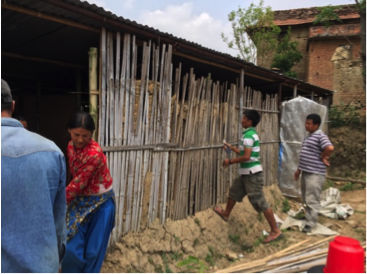
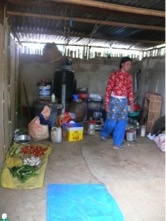
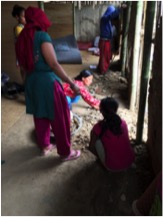
Top Left: Chicken Pens turnd into temporary shelter.
Top Right Home-sweet Home
Bottom Left: Women mud-plastering the floor
EXTRA: More updates can be seen at FACEBOOK page of Lumanti Support Group for Shelter
https://www.facebook.com/lumanti.shelter
Lumanti, in partnership with Community Women Forum and the local Women Cooperatives, is implementing Emergency Relief Program in 13 old settlements in Kathmandu Valley.
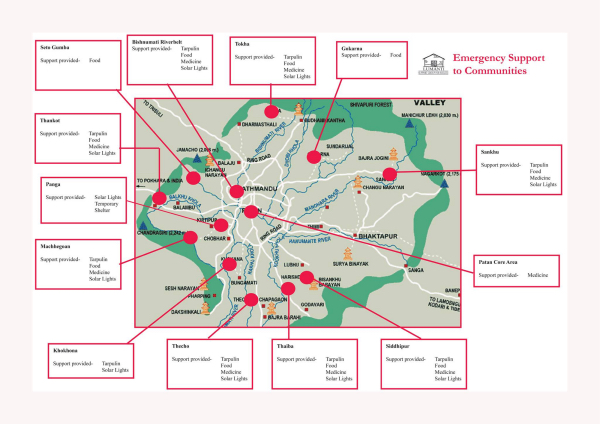
6th Update 4th May 2015
Relief Support: Women find effective ways of managing food distribution
Lumanti Support Group for Shelter
4th May 2015
The visit to the communities in Machhegoan, Thankot, Khokhona, Siddhipur, Thaiba, Thecho and talking with the affected families, the first priority of the families right now is FOOD!! They had other organizations supporting them for food for the last week but the stock has coming to an end.
We talked with the community based Women's Saving and Credit Cooperatives and community organizations. It was decided in the meetings that Lumanti provide them with monetary support, they will use the money to buy the necessary relief support and distribute them to the families who actually need them.
The mechanism used by most of the groups is as follows.
5th Update 4th May 2015
Lumanti supports to build temporary shelter in Panga, Machhegaon and Thaiba
4th May' 2015
Shaili Manandhar, volunteer in Lumanti
Today I visited Panga, Machhegaon and Thaiba with the team from Lumanti. I feel very sad to see all the destruction. In all the three communities,, Panga, Machhegaon and Thaiba, the topic of discussion between the Lumanti team and the communities was about temporary housing. The previous visits and meetings had focused on providing relief materials such as food and medicines, but today it was on temporary shelter. It was agreed that the first preference for temporary shelter will be given to people who have lost everything and no other safe houses or properties. People also agreed to coordinate with the municipalities for land and construction. I felt the community people were very co-operative, true and did not demand for anything more than what they really required. They just needed a little motivation and support from Lumanti and they looked quite confident with what they are going to do – building a home for themselves.
The following two solutions were brought up for immediate action.
Single room row housing with 12x10 size
Open Kitchen
Shared toilet and bathroom
Build 10 house in the initial phase
Tentative estimated cost (NRs) and material required for one unit of temporary shelter
Corrugated Sheets = 10,000 ( Note: 1US$ = approx 100 Nepalese Rupees )
Bamboo = 1,000
Vehicle (to transfer materials ) = 3,000
Wage for workers = 6,400 [(600 + 1000) * 6 days]
Total Cost = 20,400 (20,000 per house)
Estimation for 10 houses = 2 lakhs ( Note a Lakh is equalto 100,000 )
Advance given = 1 lakh
The estimations for Machhegaon and Thaiba were somewhat the same. Whereas, for Macchegaun people have their own properties to build temporary houses and they have demanded slightly more than the other two areas as these houses will be independent units and sharing walls. Therefore it was agreed at NRs 22,000 per house construction, and as majority of people have lost their houses in Macchegaun, they have demanded to build 20 houses immediately that sums up the total to 4 lakhs 40 thousand. Advance of 2 lakhs was given today. Technical people from Lumanti will visit these areas tomorrow to support them in planning and designing.
The community people looked very positive with Lumanti's approach. They also expressed high levels of appreciation and gratitude for the initiative – encouragement, help and support. I also felt very happy, because people who have lost everything will have a house in few days!
4th Update 4th May 2015
Updates on response to post earthquake disaster
2nd / 3rd May 2015
Panga is also raising fund at the local level to support Rs. 5000 to those households who have lost their family member in this quake, and the support is to observe local death ritual.
Lumanti and Kalimati vegetable coop distributed vegetables in 5 affected areas.
We will be working in all these areas with a vision for building long term permanent houses /communities.
Photos from Tokha, Gokarna and Thecho
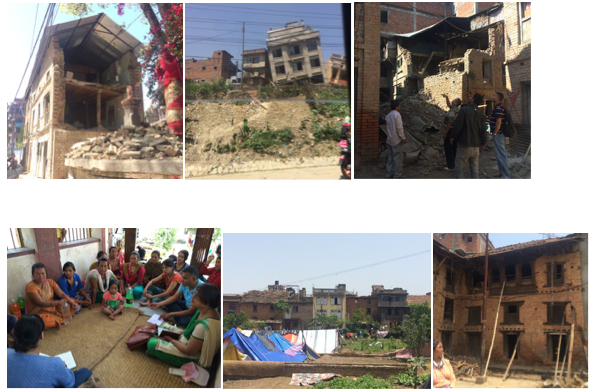
3rd Update 1st May 2015
Updates on response to post earthquake disaster
Core area in Kathmandu: Members of Prerana Cooperative visited Lumanti this morning and reported the figures of the damages that had taken place along the Bishnumati river belt in Kathmandu in Inaya Tole, Ramghat, Bhim Mukteshor and Hyumata. Tent and food supply was in demand. We provided a small fund to Sudarshana, chairperson of Prerana to make food arrangement to the needy families.
Thankot: Members of Mahila Jagaran Cooperative in Thankot visited a number of affected communities and distributed food item. Details provided in the Annex.
Thaiba: About 400 families living in a school area. The schools will re open in 2 weeks time. The people who are living there are thinking to negotiate not to leave the school but rather live in a conjested manner occupying few rooms. a cooperative is also making arrangement of food in Thaiba.
In all these area the women are also making assessment of the situation in all the affected historic communities. Many organizations are packing relief goods and visiting the communities and distributing the relief packages. We are doing it in a different and community led way. Community is assessing, making purchases as per need and demand, making arrangements and distributing by themselves with the support from Lumanti. So far all these and more communities that I am not reporting right now, have shared that they have received very little or no relief goods from the government, and they seem to be living in isolation still in a state of shock. They are relying on their own strength and resources and sharing and caring each other – the life giving source in isolation in pain and sorrow.
Annex 1 List of food distributed communities in Thankot
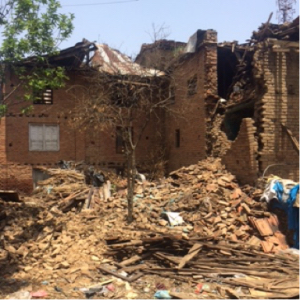
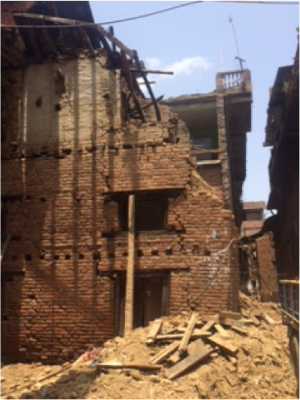
More updates can be seen at FACEBOOK page of Lumanti Support Group for Shelter
https://www.facebook.com/lumanti.shelter
2nd Update Updates on post earthquake disaster Earlier Updates are below:An ACHR - CAN team will be going to Nepal to join Lumanti and communities from 31 May to 9 June.
Below are some notes from NAD (CAN) in preparation for the visit.
Lumanti have made initial surveys with 12 communities and have found priority emergency need for temporary shelters.
Total numbers of temporary shelters that are needed now for the 12 communities is 660 units.
Lumanti has already organised and supported communities to build 160 units in 8 communities.
It needs to build 500 units more in the 12 communities.
One temporary shelter costs around 25,000 Nrp.[8,200 Baht or $425 USD]
A report update on the work of Lumanti. can be read here. This 3 page report gives a brief bacckground on the quake; the towns and communities where the efforts are / will be concentrated; and detail of the temporay housing asssistance to be supported.
And some photos of the communities.
If you wish to donate support please go here for details.
12 May 2015
Another Strong Earthquate
Again a strong EQ of 7.1 (?) was felt this afternoon at 12.56 pm local
time. A violent move of the mother earth. This terror of tremor has
not ended. The remaining old houses also collapsed. People are scared
and tonight people are planning to stay out in the open space.
We are fine, so as the staff members and volunteers of Lumanti. Some
of the staff and volunteers were in the communities supporting
constructions and assessment when EQ happened. They managed to escape
safely. People in the communities in Kathmandu are also safe.
Will write more tomorrow.
Regards
Lajana,, Lumanti Kathmandu
https://www.facebook.com/lumanti.shelter
7th Update 8th May 2015
Community Rises: post quake scenario
Lumanti Support Group for Shelter
8th May 2015
Community Led Temporary Shelter Construction in Thaiba, Lalitpur
Aftershocks have not stopped. Terror remains in the eyes of the men, women and children. But community has started rising. There is a lot to be done. Fully destroyed houses. Upper half destroyed houses. Lower part destroyed houses.
Houses with shattered walls. Cracked houses. A perfectly fine looking houses but having structural problems. Houses with red stickers (sticked by the government technical officials after damage assessment) meaning not fit for living. An isolated safe house surrounded by a number of unsafe houses. And there are hundreds of families, the owners of these destroyed and 'not fit of living' houses' who have become homeless a minute after the big earthquake on 25th April 2015. Fourteenth days after the quake, the emerging biggest challenge is arranging a temporary shelter for them. The situation is complex, and the best way to find the solution for this complex problem seems lying in the community with the people themselves. A women only saving and credit cooperative in Thaiba, Lalitpur, , found a shed meant for raising chickens to be used as a temporary shelter to housethe affected families. Partition was made by the local masons to make a room for each family, for 8 families.
Oh! at least eight families in Thaiba have a better shelter today. Better than tarpulins. Tarpulin was distributed as an emergency shelter to the affected families. But tarpaulins cannot save people from heavy rain and safety, as monsoon is approaching fast and theft has been an issue in the open tents. People are desparate to have temporary shelters, long before they can think and plan for long term reconstruction.
Lumanti gave the women's cooperative all the support they needed at this difficult hours; moral, financial and technical including access to market to purchase the construction materials. With this support they were able to provide shelters for 8 families in a day, today! The families who were going to live there, masons and other volunteers worked together to make these shelters ready. Even before giving the final touch to the completion of the shelters, people carried their belongings and moved to these rooms. .. It started raining outside. I am thinking of those hundreds of thousands who are living under the tarpaulins will have such a hard time in passing the night! Such a great need to speed up the process of construction of temporary shelters. It is also amazing how fast the communities are moving despite all odds. Tomorrow, 15 more families will be housed in the temporary shelters in Thaiba, meaning completion of the construction of 15 more homes!



Top Left: Chicken Pens turnd into temporary shelter.
Top Right Home-sweet Home
Bottom Left: Women mud-plastering the floor
EXTRA: More updates can be seen at FACEBOOK page of Lumanti Support Group for Shelter
https://www.facebook.com/lumanti.shelter
Lumanti, in partnership with Community Women Forum and the local Women Cooperatives, is implementing Emergency Relief Program in 13 old settlements in Kathmandu Valley.

6th Update 4th May 2015
Relief Support: Women find effective ways of managing food distribution
Lumanti Support Group for Shelter
4th May 2015
The visit to the communities in Machhegoan, Thankot, Khokhona, Siddhipur, Thaiba, Thecho and talking with the affected families, the first priority of the families right now is FOOD!! They had other organizations supporting them for food for the last week but the stock has coming to an end.
We talked with the community based Women's Saving and Credit Cooperatives and community organizations. It was decided in the meetings that Lumanti provide them with monetary support, they will use the money to buy the necessary relief support and distribute them to the families who actually need them.
The mechanism used by most of the groups is as follows.
- The groups have conducted a preliminary survey of the affected families and have noted the things which are priority for them right now.
- FOOD was the priority at the moment.
- The relief support provided by Lumanti was used for purchasing the supplies of the needed families.
- Then the community organization visited each camp site where at least 5 to 10 families are settled and gave the relief items to them.
- The food supply is for a week for now. The Items purchased are 1. Rice 2. Daal 3. Tea. 4. Oil and sugar.
- Other supplies purchased are medicines.
- Focus of the relief distribution are for the families who have lost everything and do not have any home to go back to and were not able to salvage any of their things from their collapsed houses.
- The preparation food is done in groups and the families in camps. And they themselves are responsible for management.
- The community cooperative themselves have contributed from their own funds to support their communities.
- Some groups also used coupon system. First, the coop members visit the camps and provide coupons to the families in need. Special attention was also given to women and children. Then, these families collect food supply for the Coop office. This arrangement was well appreciated by the beneficiaries and no conflict arose.
5th Update 4th May 2015
Lumanti supports to build temporary shelter in Panga, Machhegaon and Thaiba
4th May' 2015
Shaili Manandhar, volunteer in Lumanti
Today I visited Panga, Machhegaon and Thaiba with the team from Lumanti. I feel very sad to see all the destruction. In all the three communities,, Panga, Machhegaon and Thaiba, the topic of discussion between the Lumanti team and the communities was about temporary housing. The previous visits and meetings had focused on providing relief materials such as food and medicines, but today it was on temporary shelter. It was agreed that the first preference for temporary shelter will be given to people who have lost everything and no other safe houses or properties. People also agreed to coordinate with the municipalities for land and construction. I felt the community people were very co-operative, true and did not demand for anything more than what they really required. They just needed a little motivation and support from Lumanti and they looked quite confident with what they are going to do – building a home for themselves.
The following two solutions were brought up for immediate action.
- Rental support
Per room - Rs. 1500 per month
- Build low cost temporary shelter
Single room row housing with 12x10 size
Open Kitchen
Shared toilet and bathroom
Build 10 house in the initial phase
Tentative estimated cost (NRs) and material required for one unit of temporary shelter
Corrugated Sheets = 10,000 ( Note: 1US$ = approx 100 Nepalese Rupees )
Bamboo = 1,000
Vehicle (to transfer materials ) = 3,000
Wage for workers = 6,400 [(600 + 1000) * 6 days]
Total Cost = 20,400 (20,000 per house)
Estimation for 10 houses = 2 lakhs ( Note a Lakh is equalto 100,000 )
Advance given = 1 lakh
The estimations for Machhegaon and Thaiba were somewhat the same. Whereas, for Macchegaun people have their own properties to build temporary houses and they have demanded slightly more than the other two areas as these houses will be independent units and sharing walls. Therefore it was agreed at NRs 22,000 per house construction, and as majority of people have lost their houses in Macchegaun, they have demanded to build 20 houses immediately that sums up the total to 4 lakhs 40 thousand. Advance of 2 lakhs was given today. Technical people from Lumanti will visit these areas tomorrow to support them in planning and designing.
The community people looked very positive with Lumanti's approach. They also expressed high levels of appreciation and gratitude for the initiative – encouragement, help and support. I also felt very happy, because people who have lost everything will have a house in few days!
4th Update 4th May 2015
Updates on response to post earthquake disaster
2nd / 3rd May 2015
- We attended a meeting organized by the Insulate Dry Wall Udyog Pvt. Ltd this morning and also observed a prefab house built for demonstration. This demonstration was built before the quake hit the country. Today it stands still without any scratch. A 10 x 12 single room pre fab house costs about Rs. 900,000 and a house half of this size costs about Rs. 400,000. Although it seems good for transit housing, but cost is quite high. We will be exploring if this cost can be brought down.
- With the financial support from Lumanti, Machhegaon cooperative distributed food support to 62 households in Machhegaon, 20 HHs in Adhikary gaon and Taukhel. The Coop members visited affected households / families and distributed coupons for collection of relief (food items) at the Coop office. The food items included rice, dal, sugar, salt and oil. Similarly Siddhipur and Thecho coops also distributed food items. The system of coupons was well appreciated by the beneficiaries and no conflict arose in distribution of relief goods.
Panga is also raising fund at the local level to support Rs. 5000 to those households who have lost their family member in this quake, and the support is to observe local death ritual.
Lumanti and Kalimati vegetable coop distributed vegetables in 5 affected areas.
- Panga Coop had started filtering of the families interested in temporary shelters to be built in the 2 acres of land to be provided by two individuals ( 1 acre each). Similarly, Thaiba community has also started identifying families ready to move in a temporary shelter.
- We visited Gokarna area. Ward 9, 10 and 11 were severely affected. Six people lost life and 3 injured in gokarna. 57 houses found to be completely damaged . They had not received relief yet. We provide Rs. 65000 to the saving and credit group in the presence of the representative from ward citizen forum for providing food to the affected families for a week.
- We also visited Sankhu, the worst affected old town in the Kathmandu district. One hundred people lost their lives and all types of houses were destroyed in Sankhu. a very very sad picture exists there. A women's home based workers group called Srijanshil Shramik Mahila Samuha was provided support to provide food for affected 40 families.
- It was reported that the number of people living in the tents slowly decreased in a number of camps in different areas. This is an indication that soon demand for temporary shelter will rise. We discussed on the four possible areas of engagement in providing temporary shelters: 1) maintenance of damaged houses 2) rental support 3) construction of temporary shelters 4) training to the builders / masons 5) Assessment of the damaged houses
- We also joined Oxfam to do the initial assessment in Khokana and Bungamti. focus grou discussion held and interviews taken of the key people ffrom community. this information will be used in designing the water and sanitation support to the communities in the next one month.
- Through Thankot Coop two sets of toilet was provided to get installed at Tamang Basti Thankot.
- Request made to SSP in India to look for solar lamps. As many quake hit areas are in dark, solar lamp will be very useful for them.
- We also visited a number of informal settlement in Kathmandu. The highest hit settlement seemed to be Mandikatar with the complete damage of 25 houses. Some minor damages reported in other settlements.
- Lumanti joined the initiation of Nepal Engineers Association in assessing the damage of the households, and contributed by leading of team of few technical people and assessed the damages in the houses.
- We discussed and prepared a proposal to submit to OCHA for support in the construction of temporary shelter, mainly in Kathmandu valley. If we have adequate support, we are aiming to reach out 2500 families and work with them to construct temporary shelters.
- We also made a briefing on housing initiatives in partnership with the communities to the group of young volunteers who have raised fund but trying to get information and ideas on the best possible way to support people rebuild their lives and homes.
- We coordinated with the communities to do preparations for the construction of temporary shelters. As a result the cooperatives are in constant touch with the ward committees, ward citizen forum and political parties in finalizing land to build temporary homes and having meetings. People are ready in Thaiba and Panga, Most probably we will be starting the construction work tomorrow in Thaiba.
We will be working in all these areas with a vision for building long term permanent houses /communities.
Photos from Tokha, Gokarna and Thecho

3rd Update 1st May 2015
Updates on response to post earthquake disaster
- Damages in the informal settlements: Nepal Mahila Ekta Samaj reported on the impact of the earthquake in the informal settlements in Kathmandu. Details provided in the Annex. Compared to the damage in the historic settlements, damage in the informal settlements is far less. 5 pieces of tarpaulins is provided to Nepal Mahila Ekta Samaj for distribution to the needy families, We will be having a meeting soon with the federation leaders on the rehabilitation of the affected families in the settlements in Kathmandu.
- Responses from the Women's Cooperatives:
Core area in Kathmandu: Members of Prerana Cooperative visited Lumanti this morning and reported the figures of the damages that had taken place along the Bishnumati river belt in Kathmandu in Inaya Tole, Ramghat, Bhim Mukteshor and Hyumata. Tent and food supply was in demand. We provided a small fund to Sudarshana, chairperson of Prerana to make food arrangement to the needy families.
Thankot: Members of Mahila Jagaran Cooperative in Thankot visited a number of affected communities and distributed food item. Details provided in the Annex.
- Women's cooperative contributed Rs. 400,000 for making food arrangements. They complained that relief from government has not arrived yet, and the community was frustrated. Some wanted to shift in the rental housing, but even to find a room to rent has become a challenging issue as many people looked for rooms now.
Thaiba: About 400 families living in a school area. The schools will re open in 2 weeks time. The people who are living there are thinking to negotiate not to leave the school but rather live in a conjested manner occupying few rooms. a cooperative is also making arrangement of food in Thaiba.
In all these area the women are also making assessment of the situation in all the affected historic communities. Many organizations are packing relief goods and visiting the communities and distributing the relief packages. We are doing it in a different and community led way. Community is assessing, making purchases as per need and demand, making arrangements and distributing by themselves with the support from Lumanti. So far all these and more communities that I am not reporting right now, have shared that they have received very little or no relief goods from the government, and they seem to be living in isolation still in a state of shock. They are relying on their own strength and resources and sharing and caring each other – the life giving source in isolation in pain and sorrow.
- Distribtuion of tarpaulins: Pushkar Shrestha from CIUD was contacted for tarpaulins, as he was the focal person designated among the NGOs, to make arrangement of the tarpaulins. By afternoon we were provided 31 pieces of tarpaulins. Details of the distribution of tarpaulins will be reported tomorrow. We have ordered 600 more pieces of tarpaulins for Kirtipur and other areas. As tarpaulins were out of stock in the market in Kathmandu, and it has to be imported from India, next lot will arrive only on Monday. Just hoping that its not going to be too late. These tarpaulins are not free for us and we have to purchase these tarpaulins. Till today's record 2500HH (source Municipality) is completely damaged so need 3100 temporary tent at least to ensure shelter for these affected people in Kirtipur..
- Mobilisation of youth volunteers: We mobilized youth to report the damages in ward 23 and ward 30 in Kathmandu. Situation is pretty bad in few communities. Three people died in ward 30. People have no confidence to go back and live in their own houses. These two young men agreed to volunteer in conducting assessment of the damage in a number of wards and mobilize youth for organizing, assessment and work on future plans. They will start work from tomorrow.
- Technical assessment of damaged houses: An architect from Lumanti and members from Pro poor Technical Assistance Group (PTAG) attended a training provided by Nepal Engineers Association. Training gave a skill to assess the damage made in the buildings and to ensure the safety of the houses and building before the people return. After the training, the participants have started assessment of the houses in Basantpur area and they will be visiting communities tomorrow for the assessment of the safety according to the guidelines provided by NEA
- Community keen to lead in Dhading: It was reported that about 95% of the houses in Chhatra Deurali and Jeevanpur in Dhading district was destroyed. It was feared that food security will be a critical issues in the next few days. A volunteer has been mobilized for the assessment of the food security and other needs in these two VDCs, and support will be provided accordingly. Efforts will be made for the formation of VDC level disaster management committee with community taking key role as shown interest by the community people.
- Water and sanitation: More than 40 Volunteers mobilized for WASH awareness in camp sites and installed 9 emergency toilets at two camp sites. Till date 24 toilets have been installed in different camps. 2 water tanker of 7000Ltr and 1 tanker of 8000Ltr distributed water around kirtipur area. 10 bottles of chlorine was distributed in Thecho.
- Temporary shelter: A private land owner has volunteered to provide his 5 ropani (1 acre) of land to construct temporary shelters for the affected families in Kirtipur. We will be discussing more on this matter tomorrow. The community women leaders have started looking for land for the construction temporary shelter.
Annex 1 List of food distributed communities in Thankot
- Balambu:
- Dahachowk
- Salangal
- Kisipidhi
- Bari gaon


More updates can be seen at FACEBOOK page of Lumanti Support Group for Shelter
https://www.facebook.com/lumanti.shelter
30th April 2015
Lajana Manandhar
Lumanti Support Group for Shelter ( Note: 1US$ = approx 100 Nepalese Rupees )
1. Community initiations in assessment, dealing with relief and other support in Kathmandu valley: Thankot Women's Cooperative reported that 400 houses were completely damaged. There is a demand for tarpaulins, medicines and food. The cooperative has contributed 3 lakh rupees and Lumanti contributed Rs. 2 lakh to provide food and medicine support to the needy and affected families in Thankot. 50 families in Dahachowk and 30 families in Thankot will be provided meals. They have already purchased rice 30 sacks, 1 sack dal, 1 sack sugar, tea 5 kg, 1 sack salt and 10 box biscuits. This relief support will be managed by the cooperative linking with the Local Disaster Management Committee.
In Machhegaon, food was in short supply. Until today, a local Buddhist monastery has been providing food for about 100 affected families. As they ran out of fund today is the last day that they could provide food support. Therefore, from tomorrow onwards women's cooperative will take care of providing meals to the families for one week with the support from Lumanti and mobilizing their own fund. In addition, the cooperative has also allocated Rs. 25000 to spend in meeting medical expenses for the needy families. The cooperative members are trying to reach all the affected families.
In Siddhipur,, it was reported that 72 houses were completely destroyed, 450 houses although not collapsed, but not in the livable condition and the death toll was 11. Local people has established 'Siddhipur Relief Fund 2072' for mobilization of support at the local level. All the support going to Siddhipur will be channelized through this Fund. They had receive 53 tarpulins. Demand is for medicines, chlorine and food. We have channelized our support through this Fund to provide support as demanded by the community.
In Khokana, it was reported that 700 houses were not in a livable condition. Tarpulins are in demand and they have not received it in adequate number. The community is not happy with the distribution mechanism, and they think its been ineffective. Water born disease is already seen. The cooperative has contributed Rs. 50,000 and Lumanti has provided Rs. 200,000 for relief support to the cooperative.
In the core Kathmandu; along the Bishnumati river belt area, Prerana women's cooperative identified that in Ramgaht, Hyumata and Inaya tole area, 10 houses were completely damaged and 38 houses were not in a livable condition. Here also Lumanti is working with the cooperative to mobilize relief support.
More communities were visited in Lalitpur and other areas and also contacts being made through telephones for mobilizing relief support and for the assessment of the damage.
2. In Kirtipur, volunteers mobilized for water, sanitation and hygiene awareness in existing ward level camps - 3 team of trained volunteers 5 members each mobilized in existing camps to raise awareness on WASH including water purification along with Piyush and IEC materials. Lumanti had trained and prepared 2200 trained volunteers in Kirtipur to support in assessment of the situation, rescue operation, providing first aid and relief distribution. Support and materials provided for the construction of total 20 sets of toilets by mobilizing volunteers from KVS (Kirtipur Volunteer society ) along with ward level trained volunteers as per request and requirement of the existing camp site. Water distributed through tanker around Kirtipur area.
Few sub committees were also formed to look into situation assessment, relief and fund management, WASH awareness, improving security and managing setting up new ware houses for storing relief materials. Lumanti and Nepal Red Cross identified as the key supporters to all these sub committees. Decision was also taken that in Kirtipur, all the relief support will be managed by the ward level Community Disaster Management Committees. Lumanti had provided support in setting up these committees ( in the last 2 years) as a part of preparation to face disaster.
3. Oxfam is planning to provide relief support ( with a focus on food security, WASH and shelter) in 3 districts; Kathmandu. Lalitpur and Bhaktapur. Their two partners including Lumanti will work to cover these 3 districts. Lumanti will work in Kathmandu and some parts in Bhaktpur. Detail assessment will begin from tomorrow.
4. Few of our own staff members were also badly affected as they loss house and all the belongings in the house. The meeting held this afternoon made a decision to provide rental and other necessary relief support to them.
Lajana Manandhar
Lumanti Support Group for Shelter
1st Update from
Lajana Manandhar, Lumanti, Kathmandu, Nepal
29th April 2015
1. Background: There has been a rumour, and this rumour has been going on for some time. The rumour was Kathmandu may hit with major earthquake any time. Preparations to address the disaster was emphasised. Tall and haphazardly constructed building were seen as 'not safe structures'. But people did not seem to be listening. The last major earthquake with 8.3 richter scale that happened was in 1934. It had become an historic event, and may be we had felt that it was a just a talk that would never happen in our lives. But Nepal saw it, felt it happened in real life. A 7.9 richter scale earthquake shook most part of the country, and left with massive destruction in human casualties and physical property living people in unforgettable pain and tears. Nobody lived in the house for few days. Well thousands of old houses and temples were completely destroyed. Even the people who did not lost their houses, stayed outside homes under the plastic sheets as thee were strong after shocks going on, and nobody dared to go inside. About 40 percent of the population were affected by this disaster in different part of the country.
2. Soon after the disaster, we heard support from many countries poured in. National Disaster Fund was also established. But relief was not reaching to the people in need. In many of the historic towns in Kathmandu, we had supported in establishing women's saving and credit cooperatives who had been active in organizing women and also engaged in small scale infrastructure improvement activities. The members of these cooperatives were also badly affected by the disaster. Its only today (29th April 2015) telephone connections improved with access to electricity, otherwise since disaster there was no electricity, and the network was very bad.
3. As telephone connections improved, report started coming in, and our own visit also improved. Our own team members had also suffered massive blow of this disaster as about 10 families had to move from their homes due to partial / full damage. They don't have their own place to live and currently relying on the support for relatives. All of them badly need proper temporary shelter.
4. We have connected, visited these communities in Kathmandu valley; Thankot, Thaiba, Panga, Kirttipur, Machhegoan, Sano gaon, Thecho, Khokana, Tokha, Kathmandu, Lalitpur. Gokarna, Thimi, and a community in Dhading district. Except Dhading, all are historic old towns, and all the old houses proved to be very weak and completely collapsed including temples and so on. On an average it seems that each of these communities lost about 100 old houses, this means 100 families have become homeless. Partial damaged houses are not yet counted. Kathmandu Metropolitan city has started assessing the condition of the partial damaged houses to ensure the safety of the structure before people return from open space. But in the small town this service is lacking we are planning to pressure the govt to start this service. As people will now slowly try to move to their homes as the tremor gets weakened.
5. Tomorrow we will be supporting the cooperatives to start a basic survey of the affected families and map the situation on the ground. This information will be shared in the meetings to get necessary support from the government.
6. The quick immediate assessment taken in few communities different towns showed : a great demand for tarpaulins (for the families who homes), small cash support for medicines and special needs of women and children, and support for food. As people were staying outside, they were cooking and eating in a common kitchen. They needed support to get this common kitchen going on for few days.
7. In the city core area, the families who were displaced also needed rental facilities / temporary shelter and as it was not possible to stay with the relatives for a long time.
8. As per need and demand, so far we have mobilized support for tarpaulins, drinking water, sanitation facilities and we will be providing support for fooding and small cash support from tomorrow onwards. Immediate support is required for this purpose.
9. Department of Urban Development and Building Corporation is leading shelter cluster group meeting, and they are going to meet every day from 9 – 10 am. We are a part of this group and will be attending the meetings. My first attendance to this meeting this morning made me feel that we really need to push hard for community led relief and rehabilitation work. UN Habitat is positive and we will be working with them closely.
10. We will also be reaching outside Kathmandu as very little support is going out. Few organisations are joining and meeting tomorrow on mobilising some resources outside the valley.
11. Few meetings to be held tomorrow, and some discussion will be made on long term rehab plan as well. I will write again tomorrow.
Lajana Manandhar, Lumanti
29th April 2015
More Updates soon .......
28/4/15
Lumanti Joshi in Kathmandu is also keeping friends up to date with photos and messages on her FACEBOOK page HERE
Lumanti Joshi added 24 new photos.
11 hrs ·
Machhegaon, taukhel area where we had our workshop justlast month!! More than 90 houses have completely collapsed . 4 people from community died. People are helping each other, cleaning debris, rescueing trapped people, everything.. .... People have the power to come over this terrible situation.. nepal is a strong country !!!
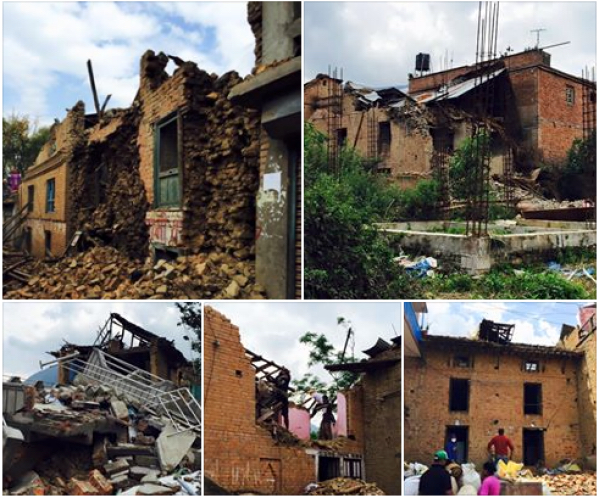
You can donate via the ACHR or Lumanti Accounts Go here for details
Some of the experienced Lumanti team and friends in Nepal
.jpg)
The national community developemnt process in Nepal is not starting from scratch - it is embedded in a well-established and close collaboration between an NGO and two national people’s federations which began just ten years ago. Lumanti is the key NGO in Nepal working to support the urban poor. It was established in 1993, in a situation where the squatters didn’t know each other and lots of evictions were happening. They began supporting communities in Kathmandu in 1998, using community surveys and savings to bring people together. Gradually, they began doing training programs, exchange visits to other countries, children’s groups, upgrading activities, water and sanitation projects, and invited the municipality to see all these projects.

about Lumanti and previous programs HERE
about ACHR experience with previous disasters HERE
Why is people centred recovery important ?

about Lumanti and previous programs HERE
about ACHR experience with previous disasters HERE
Why is people centred recovery important ?
30 APRIL 2015
.jpg)
From THE NATION Bangkok




